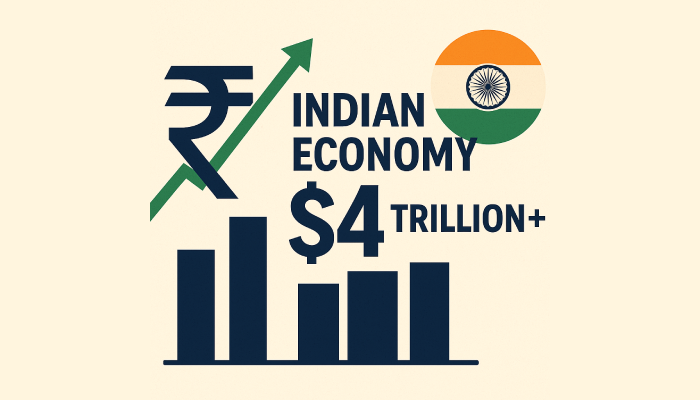India’s GDP Crosses $4 Trillion Mark as Economy Surges Past Japan; Growth Momentum to Make India 3rd Largest by 2028
India has officially surpassed Japan to become the world’s fourth-largest economy, marking a pivotal moment in the country’s economic journey. According to the International Monetary Fund’s (IMF) latest data, India’s nominal Gross Domestic Product (GDP) has surged to $4.187 trillion, pushing it ahead of Japan in the global rankings.
The announcement was confirmed by NITI Aayog CEO B.V.R. Subrahmanyam during the 10th Governing Council Meeting of the policy think tank. “We are the fourth-largest economy as I speak. We are a USD 4 trillion economy, and this is not my data—it’s IMF data. India today is larger than Japan,” he said. “Only the United States, China, and Germany are ahead of us. If we stick to what is being planned and thought through, it’s just a matter of another 2 to 3 years before we become the third-largest economy.”
“It’s just a matter of 2 to 3 years before we become the third-largest economy.”
— B.V.R. Subrahmanyam, CEO, NITI Aayog
India’s Growth Momentum
India’s economic rise is fueled by a combination of robust domestic consumption, aggressive digital transformation, and forward-looking policy reforms such as the Production Linked Incentive (PLI) schemes, Digital India, and Make in India initiatives. These structural drivers are creating a sustainable platform for long-term growth and enabling India to stand out amid global economic uncertainties.
According to the IMF World Economic Outlook, India is projected to become the third-largest economy by 2028, with a GDP forecast of $5.58 trillion, overtaking Germany, whose GDP is expected to reach $5.25 trillion by then. Meanwhile, Japan and Germany continue to experience stagnant or marginal growth, weighed down by aging populations, global trade frictions, and structural inefficiencies.
A Decade of Economic Transformation
India’s climb in global economic rankings is not a sudden development but the result of a decade of sustained reform and discipline. As noted by Dr. Radhika Ahuja, Chief Economist at Global Growth Analytics, “This milestone is not just a number—it reflects a decade of sustained economic discipline, digital transformation, and scalable public infrastructure.”
India’s digital public goods infrastructure—including Aadhaar, UPI, and DigiLocker—has provided a strong backbone for inclusion and scale. Combined with a tech-savvy population and increasing global investor confidence, the country is now building a new economic growth model grounded in resilience, entrepreneurship, and inclusiveness.
The Rise of a Digital, Democratic Superpower
Beyond the statistics, India’s economic momentum signals a deeper geopolitical and economic rebalancing in the post-COVID world. As traditional powerhouses in Europe and Asia grapple with economic stagnation, India’s ability to deliver growth through innovation and public-private synergy is attracting global attention.
“India’s ascent in global rankings is a story of entrepreneurial dynamism and policy clarity,” said Sanjeev Mehta, CEO of Bharat Innovation Council. “The world is witnessing the rise of a digital, democratic economic superpower.”
India’s demographic advantage—a youthful, digitally literate workforce—is also playing a central role. With nearly 65% of the population under the age of 35, the country offers both scale and speed, making it an attractive destination for global capital, supply chain investments, and innovation partnerships.
A Larger Role on the Global Stage
India’s economic rise comes at a time when global supply chains are being restructured, and countries are seeking trusted, scalable alternatives to traditional manufacturing hubs. India’s strategic location, maturing startup ecosystem, and policy incentives make it a strong contender to play a much bigger role in global trade, technology, and innovation ecosystems.
As it eyes the third spot in the global economy by 2028, India’s trajectory signals not just domestic success but also its growing influence on the world stage. With the right mix of policy execution, infrastructure investment, and global collaboration, India is well on its way to becoming a key architect of the 21st-century global economy.


